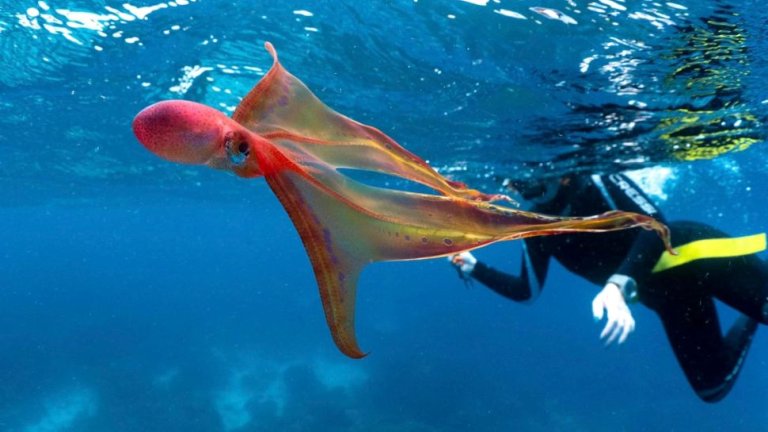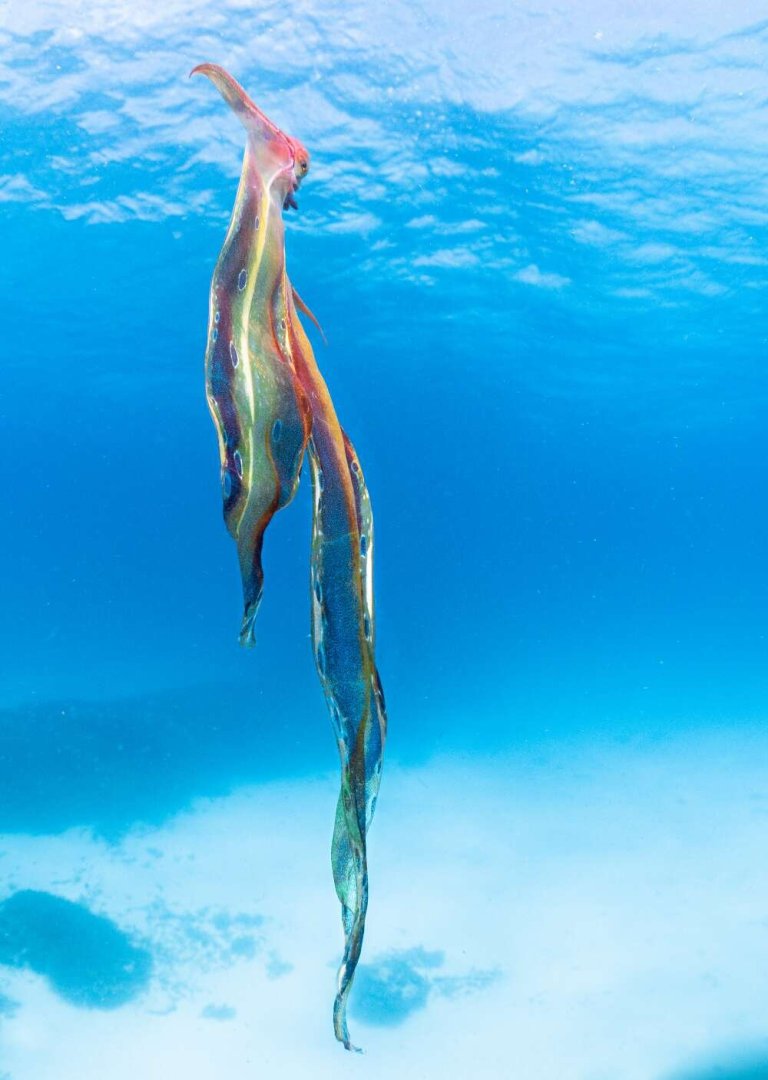Blanket Octopus Profile
There’s a very rare cephalopod in the reefs and open waters of the tropics, that was so elusive, the males have only been spotted a handful of times and were first recorded alive around the turn of the millennium.
These octopuses are members of the Tremoctopus genus, of which there are four species, and are named after their huge blanket webs, which they present as a means of defence when threatened.
Meet the breathtaking blanket octopus.

Blanket Octopus Facts Overview
| Habitat: | Tropical and warm oceans, usually pelagic or reef |
| Location: | Mediterranean, Caribbean |
| Lifespan: | Possibly up to 4 years |
| Size: | 2” to 6’7” (2.5cm to 2 meters) |
| Weight: | Up to 12kg or 26lb |
| Color: | Creamy coloured, with shimmering greens, purples and reds |
| Diet: | Small fish, molluscs, crustaceans |
| Predators: | Blue sharks, tuna, other large predatory fish |
| Top Speed: | Slow |
| No. of Species: |
4 |
| Conservation Status: |
Least Concern |
The blanket octopus has some unique qualities. It uses weapons, casts a net and presents some peculiar differences between the sexes.
The four species are rare, possibly rather intelligent creatures who migrate both daily and seasonally in search of hunting grounds and favourable climates.
Not much can be known about an animal this elusive, but one thing’s for sure, they’re very good at defending themselves and the females have the upper hand when it comes to wrestling…
Interesting Blanket Octopus Facts
1. Female are a hundred times larger than the male
Female blanket octopuses are two orders of magnitude larger than the males, making them the most sexually dimorphic, or ‘physically different’ in size of any animal that isn’t microscopic.
Not only are they much larger, but they’re also substantially heavier. A male blanket octopus might max out at 2.5cm, or one inch long and it would take more than 10,000 of them to match the weight of the 2 meter, 6’7” female.
This size difference between the sexes is seen in a number of marine animals, and this, at least in terrestrial animals, usually implies a divergence from monogamic mating strategies. What this translates to is that these enormous females likely take on numerous mates in their drive to reproduce. 1

2. Males give their right arm for a mate
The tiny males, if they’re lucky enough to find a receptive female, hands over a fist full of sperm, attached to a modified arm, which subsequently detaches from the male’s body.
This arm is called a hectocotylus and it’s thought that the males only get one. Once it’s done, there isn’t much use in them hanging around, and they probably die soon after mating.
Differences in this hectocotylus are used to determine species for taxonomic purposes.
The female, on the other hand, keeps multiple parcels of sperm from her various suiters in her mantle, which she can choose to use when she feels like it.
3. They weaponise jellyfish
These octopuses are immune to the sting of the Portuguese Manowar (okay, it’s not technically a jellyfish, but as far as tentacles go, it’s close enough).
The octopus will tear off these tentacles and wear them as a defence, and possible to catch prey. However, this is an advantage the females don’t have.
The size of the female makes the Manowar tentacles ineffective against larger predators. This defence mechanism is used only by the males since their predators are much smaller and more susceptible to the painful stings.
4. The females use a blanket
Instead of stinging, female blanket octopuses use a web of skin between their limbs which can make her appear much larger in an attempt to fend off predators.
If this doesn’t work, it also detaches quite easily if attacked and can be used as a decoy. 2
5. Species can be determined by how they use this blanket
In two of the Tremoctopus species, the females will detach this web, which is said to imitate the shape of their eggs. Typically, it’s been described as immediately expanding to the size of a handkerchief when released, with its bright spots blazing in a dazzling display.
The spots are said to resemble clusters of eggs, which may function as an appealing decoy to predators.
The shape this makes differs between the two species and can be used to tell them apart.
6. They take part in 3D migrations
During the cold months, blanket octopuses migrate from deeper water into shallows for warmth.
But they also take part in a daily vertical migration, up and down in the water column. So, these are animals who migrate both vertically and horizontally in their environment.
7. They’re hard to find!
In the last three years, scientists working on the Great Barrier Reef have come across the blanket octopus only three times.
Similar stories from all over the world show us that these are very elusive and uncommon animals, but all four species are listed as “of least concern” by the IUCN, despite limited data presented on their populations. 3
8. Males have huge eyes
The male has what look like big googly eyes on its head, which is perhaps an adaptation to finding mates since the male blanket octopus is so tiny. The male eyes are relatively enormous compared with their body, at a much bigger ratio than the female’s.
With this and the modified arm, they’re perhaps well suited to hunt for females, despite their tiny size.
9. They have the full Octopodian arsenal
Many unfounded claims are made that the blanket octopus doesn’t have ink; suggesting that its more creative defences are a response to a natural lack of an inherent escape system. However, it appears blanket octopuses have all of this and more.
They are able to change colour, make use of countershading, spray ink and jet off in a rapid burst manoeuvre as a response to threats. That’s on top of their use of tentacles and detachable leathery blankets. 4

Blanket Octopus Fact-File Summary
Scientific Classification
| Kingdom: | Animalia |
| Phylum: | Mollusca |
| Class: | Cephalopoda |
| Order: | Octopoda |
| Family: | Tremoctopodidae |
| Genus: | Tremoctopus |
| Species Names: |
Tremoctopus gelatus (Gelatinous blanket octopus) Tremoctopus robsoni Tremoctopus gracilis (Palmate octopus) Tremoctopus violaceus (Common blanket octopus) |
Fact Sources & References
- M. D. Norman (2002), “First encounter with a live male blanket octopus: the world’s most sexually size-dimorphic large animal“, RSNZ.org.
- Nixon and Young (2016), “Deployable Web Distracts Predators“, Ask Nature.
- Bertin Huynh (2022), “Dancing through the water’: rare sighting of blanket octopus in Great Barrier Reef“, The Guardian.
- Neues Jahrbuch für Geologie und Paläontologie – Abhandlungen (2012), “Exaptations in Argonautoidea (Cephalopoda: Coleoidea: Octopoda)“, Research Gate.
